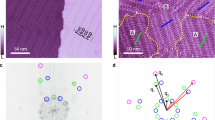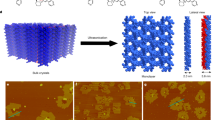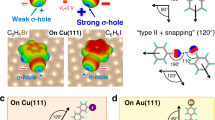Abstract
Self-assembly1,2 of adsorbed organic molecules is a promising route towards functional surface nano-architectures, and our understanding of associated dynamic processes has been significantly advanced by several scanning tunnelling microscopy (STM) investigations3,4,5,6,7. Intramolecular degrees of freedom are widely accepted to influence ordering of complex adsorbates, but although molecular conformation has been identified8 and even manipulated9,10,11 by STM, the detailed dynamics of spontaneous conformational change in adsorbed molecules has hitherto not been addressed. Molecular surface structures often show important stereochemical effects as, aside from truly chiral molecules12,13,14,15, a large class of so-called prochiral molecules16,17,18,19 become chiral once confined on a surface with an associated loss of symmetry. Here, we investigate a model system in which adsorbed molecules surprisingly16 switch between enantiomeric forms as they undergo thermally induced conformational changes. The associated kinetic parameters are quantified from time-resolved STM data whereas mechanistic insight is obtained from theoretical modelling. The chiral switching is demonstrated to enable an efficient channel towards formation of extended homochiral surface domains. Our results imply that appropriate prochiral molecules may be induced (for example, by seeding) to assume only one enantiomeric form in surface assemblies, which is of relevance for chiral amplification and asymmetric heterogenous catalysis.
This is a preview of subscription content, access via your institution
Access options
Subscribe to this journal
Receive 12 print issues and online access
$259.00 per year
only $21.58 per issue
Buy this article
- Purchase on Springer Link
- Instant access to full article PDF
Prices may be subject to local taxes which are calculated during checkout




Similar content being viewed by others
References
Yokoyama, T., Yokoyama, S., Kamikado, T., Okuno, Y. & Mashiko, S. Selective assembly on a surface of supramolecular aggregates with controlled size and shape. Nature 413, 619–621 (2001).
Theobald, J. A., Oxtoby, N. S., Phillips, M. A., Champness, N. R. & Beton, P. H. Controlling molecular deposition and layer structure with supramolecular surface assemblies. Nature 424, 1029–1031 (2003).
Lin, N., Dmitriev, D., Weckesser, J., Barth, J. V. & Kern, K. Real-time single-molecule imaging of the formation and dynamics of coordination compounds. Angew. Chem. Int. Edn 41, 4779–4783 (2002).
Yanagi, H. et al. Molecularly resolved dynamics for two-dimensional nucleation of supramolecular assembly. Nano Lett. 2, 601–604 (2002).
Schunack, M. et al. Long jumps in the surface diffusion of large molecules. Phys. Rev. Lett. 88, 156102 (2001).
Lauhon, L. J. & Ho, W. Single molecule thermal rotation and diffusion: Acetylene on Cu(001). J. Chem. Phys. 111, 5633–5636 (1999).
Gimzewski, J. K. et al. Rotation of a single molecule within a supramolecular bearing. Science 281, 531–533 (1998).
Jung, T. A., Schlittler, R. R. & Gimzewski, J. K. Conformational identification of individual adsorbed molecules with the STM. Nature 386, 696–698 (1997).
Moresco, F. et al. Conformational changes in single molecules induced by scanning tunneling microscopy manipulation: A route to molecular switching. Phys. Rev. Lett. 86, 672–675 (2001).
Loppacher, Ch. et al. Direct determination of energy required to operate a single molecule switch. Phys. Rev. Lett. 90, 066107 (2003).
Qiu, X. H., Nazin, G. V. & Ho, W. Mechanisms of reversible conformational transitions in a single molecule. Phys. Rev. Lett. 93, 196806 (2004).
Ortega Lorenzo, M., Baddeley, C. J., Muryn, C. & Raval, R. Extended surface chirality from supramolecular assemblies of adsorbed chiral molecules. Nature 404, 376–378 (2000).
Kühnle, A., Linderoth, T. R., Hammer, B. & Besenbacher, F. Chiral recognition in dimerization of adsorbed cysteine observed by scanning tunnelling microscopy. Nature 415, 891–893 (2002).
Lopinski, G. P., Moffatt, D. J., Wayner, D. D. M. & Wolkow, R. A. Determination of the absolute chirality of individual adsorbed molecules using the scanning tunnelling microscope. Nature 392, 909–911 (1998).
Fang, H., Giancarlo, L. C. & Flynn, G. W. Direct determination of the chirality of organic molecules by scanning tunneling microscopy. J. Phys. Chem. B 102, 7311–7315 (1998).
Weckesser, J., De Vita, A., Barth, J. V., Cai, C. & Kern, K. Mesoscopic correlation of supramolecular chirality in one-dimensional hydrogen-bonded assemblies. Phys. Rev. Lett. 87, 096101 (2001).
Chen, Q. & Richardson, N. V. Enantiomeric interactions between nucleic acid bases and amino acids on solid surfaces. Nature Mater. 2, 324–328 (2003).
Böhringer, M., Schneider, W.-D. & Berndt, R. Real space observation of a chiral phase transition in a two-dimensional organic layer. Angew. Chem. Int. Edn 39, 792–795 (2000).
Brian France, C. & Parkinson, B. A. Naphto[2,3-a]pyrende forms chiral domains on Au(111). J. Am. Chem. Soc. 125, 12712–12713 (2003).
Gothelf, K. V., Brown, R. S., Thomsen, A. & Nielsen, M. 1,4-Bis[(5-tert-butyl-3-formyl-4-hydroxyphenyl)ethynyl]benzene (synthesis). World patent 2004050231 (2004).
Parschau, M., Romer, S. & Ernst, K.-H. Induction of homochirality in achiral enatiomorphous monolayers. J. Am. Chem. Soc. 126, 15398–15399 (2004).
McFadden, C. F., Cremer, P. S. & Gellman, A. J. Adsorption of chiral alcohols on “chiral” metal surfaces. Langmuir 12, 2483–2487 (1996).
Lægsgaard, E., Besenbacher, F., Mortensen, K. & Stensgaard, I. A fully automated, timble-size scanning tunneling microscope. J. Micros. 152, 663–669 (1988).
Hammer, B., Hansen, L. B. & Nørskov, J. K. Improved adsorption energetics within density-functional theory using revised Perdew-Burke-Ernzerhof functionals. Phys. Rev. B 59, 7413–7421 (1999).
Bahn, S. R. & Jacobsen, K. W. An object-oriented scripting interface to a legacy electronic structure code. Comp. Sci. Eng. 4, 56–66 (2002).
Frauenheim, Th. et al. A self consistent charge density functional based tight-binding method for predictive materials simulations in physics, chemistry and biology. Phys. Status Solidi B 217, 41–62 (2000).
Acknowledgements
We acknowledge the financial support from the EU programs FUN-SMART and AMMIST, as well as from the Carlsberg Foundation, the Danish Technical Research Council and from the Danish Natural Science Research Council through funding for the iNANO centre. We thank A. H. Thomsen and M. Nielsen for synthesizing the molecules.
Author information
Authors and Affiliations
Corresponding author
Ethics declarations
Competing interests
The authors declare no competing financial interests.
Supplementary information
Supplementary Information
Supplementary movie S1 (AVI 167 kb)
Rights and permissions
About this article
Cite this article
Weigelt, S., Busse, C., Petersen, L. et al. Chiral switching by spontaneous conformational change in adsorbed organic molecules. Nature Mater 5, 112–117 (2006). https://doi.org/10.1038/nmat1558
Received:
Accepted:
Published:
Issue Date:
DOI: https://doi.org/10.1038/nmat1558
This article is cited by
-
Chirality control of a single carbene molecule by tip-induced van der Waals interactions
Nature Communications (2023)
-
Chiral nanoporous networks featuring various chiral vertices from an achiral molecule on Ag(100)
Nano Research (2022)
-
Simultaneous switching of supramolecular chirality and organizational chirality driven by Coulomb expansion
Nano Research (2022)
-
Towards single-species selectivity of membranes with subnanometre pores
Nature Nanotechnology (2020)
-
Sub-molecular structural relaxation at a physisorbed interface with monolayer organic single-crystal semiconductors
Communications Physics (2020)



